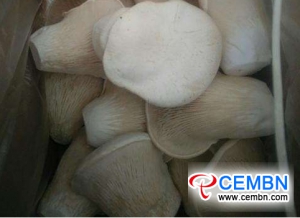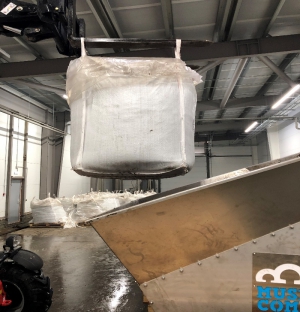
Mushroom Matter
Welcome on our platform. Why MUSHROOM MATTER? Because mushrooms play an important role in our lives as well in business. Our goal is to bring the world the very latest mushroom news with the upmost care to support the positioning of our beloved Mushroom.
How about growing Hericium mushrooms in caves?
Hericium mushroom (Monkey head mushroom) falls under with wood-rotting fungi and it is a kind of low-temperature type mushroom. Suitable temperature range for growth of mycelia is 6-34 degrees Celsius, the optimal range is at 25 degrees Celsius or so. When it is under 6 degrees, metabolizable action of mycelia stops while growth of mycelia is in tardy trend and easy to age at above 30 degrees Celsius. When it reaches 35 degrees Celsius, mycelia stop growing.
Besides, suitable temperature range for growth of sporocarp is 12-24 degrees Celsius and the ideal range is 18-20 degrees Celsius. When the temperature reaches over 25 degrees Celsius, sporocarps of Hericium mushroom lead slow growth or they are hard to form. And, when the temperature is below 10 degrees Celsius, sporocarps turn red. As temperature gets down, the color becomes darker, which indicates the insignificance of edible value.
Now, in China, time for artificial Hericium mushroom cultivation in greenhouse usually starts from November to next April, therefore, from May to October, it is hard to find fresh Hericium mushrooms in the market.
Hericium mushrooms cultivated in caves imply a new prosperous path. In southwest of Guangxi, China, there are many natural caves that feature karst landform. In these caves, temperature is kept at a range of 17-20 degrees Celsius all the year round while the humidity is always at 80% or so, which makes them the ideal environment for Hericium mushroom cultivation. Following this kind of cultivation pattern, market blank of fresh Hericium mushroom during May to October could be filled up in China.
As known to all mushroom growers, Hericium mushroom is aerobic, it is quite sensitive to the concentration of carbon dioxide, when the concentration of carbon dioxide in the air is higher than 0.1%, stems are stimulated to constantly branch and that fatally results in malformed mushrooms, hence it is of crucial importance to sustain fresh air in the caves. When necessary, growers could add air supply system in the caves.
During the formation phase of sporocarps, 85%-90% of air humidity is ideal, during that phase, sporocarps grow quickly and become white, supposing that air humidity is under 70%, surface of sporocarps seriously loses water, mushroom bodies become dry, shrunken and yellow. On the contrary, when it is higher than 95%, mushroom bodies are branched.
In many corn production areas in China, corncobs are mostly burned as firewood, which discloses low value in use. In response to the situation, corncobs are ably reused for Hericium mushroom cultivation. Specifically, after combining with smashed corncobs, sawdust, wheat bran, brown sugar and other selenium-rich raw materials, nutrient bags used for Hericium mushroom cultivation are higher in nutrition and more capable to promote the high output. Meanwhile, air, water and soil in the caves are free from pollution, rich mineral substances and microorganisms also elevate the high and healthier yield.
Anhui Zhougudui Market: Analysis of Mushroom Price
According to mushroom quotation provided by Anhui Zhougudui Agricultural Products Wholesale Market, on August 5, White beech mushroom, Brown Shimeji mushroom, King oyster mushroom, Enoki mushroom and Cordyceps militaris are 5 varieties that show price rise.
1.Price of White beech mushroom has risen from 12.5 to 15 CNY per kg, indicating 20% of increase range.
2.Price of Brown Shimeji mushroom has risen from 12.5 to 14.2 CNY per kg, indicating 14% of increase range.
3.Price of King oyster mushroom has risen from 5 to 5.5 CNY per kg, indicating 10% of increase range.
4.Price of Enoki mushroom has risen from 3.8 to 4.3 CNY per kg, indicating 13% of increase range.
5.Price of Cordyceps militaris has risen from 15 to 16 CNY per kg, indicating 7% of increase range.
On the contrary, by August 5, Agrocybe cylindracea, Pleurotus geesteranus, Seafood mushroom, Shiitake mushroom, Button mushroom and Pleurotus nebrodensis are 6 mushroom varieties that show price fall.
1. Price of Agrocybe cylindracea has dropped from 13.8 to 11 CNY per kg, indicating 20% of decline range.
2. Price of Pleurotus geesteranus has dropped from 14.7 to 12.5 CNY per kg, indicating 15% of decline range.
3. Price of Seafood mushroom has dropped from 7 to 6 CNY per kg, indicating 14% of decline range.
4. Price of Shiitake mushroom has dropped from 13 to 12 CNY per kg, indicating 8% of decline range.
5. Price of Button mushroom has dropped from 10 to 8.8 CNY per kg, indicating 12% of decline range.
6. Price of Pleurotus nebrodensis has dropped from 22.4 to 18.8 CNY per kg, indicating 16% of decline range.
“Recently, price of industrialized (factory-mode) mushroom varieties is in varying degrees of increase while price of other varieties also fluctuates at a normal range,” introduces manager of Anhui Zhougudui Agricultural Products Wholesale Market warmly.
TenCate Nicolon in the spotlight
What does water and a bag have to do with TenCate? Actually quite a lot as they thank their company existence to Dutch Nico ter Kuile. During the North Sea flood a large part of the coast of the Netherlands was destroyed. Nico was weaving synthetic bags and filled them with sand to keep the water coming further land inwards. His idea was picked up after and accelerated quickly to huge innovations in the usage of Geosynthetics and company TenCate Nicolon was born.
To protect the Netherlands from further damage, they began to build huge storm barriers “Dutch Delta Works” with products from Nicolon. High strength woven textiles were used to strengthen these barriers which was the first time in history this was done with this technique. The use of Geosynthetics began to develop worldwide and TenCate was quick to be at the forefront of this development. During the period 1960 and 2005 TenCate grew their American, European and Asian markets by acquiring companies with a strong focus on Synthetics and established multiple factories over the world.
Due to the important role and accomplishments in Dutch history, TenCate has become a Royal Company.
Team Mushroom Matter visited the location of TenCate Nicolon (nowadays TenCate Geosynthetics) in Hengelo the Netherlands last week and learned all about this history and company mission en vision.
TenCate Geosynthetics is a dutch multinational and is one of the market leaders in geosynthetics and industrial fabrics.
According to commercial director Jan-Willem Heezen, specialization is the key in order to stay successful in business. Instead of being a big conglomerate with a lot of diversifications, TenCate was able to make the necessary changes to stay on top of the market.
In order to strengthen the company and be robust enough for the future, TenCate developed multiple specialized brands.









TenCate is active in the following markets with their brands:
- Building site infrastructure
- Transportation infrastructure
- Local government infrastructure
- Natural resources & Energy infrastructure
- Water infrastructure
- Environmental infrastructure
- Industrial Fabrics
TenCate and their role in the mushroom market
TenCate Industrial Fabrics is a commercial division of TenCate Geosynthetics and supplies products and solutions for agricultural, recreational and specialty markets. Products are sold under the brands TenCate Toptex, TenCate Nicolon and TenCate Permatron.
TenCate Geosynthetics has a global production platform, commercial and technical organization and has successfully consolidated and developed core markets to maximize value for customers. TenCate Geosynthetics serves the market globally with two commercial divisions - TenCate Geosynthetics and TenCate Industrial Fabrics.
Through the processing of synthetic raw materials, TenCate develops, manufactures, and provides innovative and reliable industrial technical textiles that enhance the performance of our customers’ products.
For more than 30 years TenCate produces and supplies growing nets and compost pulling nets for the mushroom market. TenCate Nicolon nets have become the industry standard by its proven performance and reliability. Flexibility and quality is the core of doing business according to Maarten Bos, Market Manager of TenCate Industrial Fabrics.
TenCate Mushroom farming applications are:
- Growing & casing nets
- Tunnel & Glide nets
- Growing house covers
- Composting covers
- Straw covers
- Storage & construction liners
- Hygiene mats


More information can be found on www.nicolon-nets.com
Handling of imported casing soil
A lot of farms around the globe are using imported casing soil from Europe. A good, heavy casing soil with a good water holding capacity will give many benefits and are making it worth the investment to import the casing from that far away instead of using other alternatives. However, it’s really important to prepare the casing soil the right way and get the casing on the growing beds the right way, without losing those benefits. Getting a good, consistent casing on the beds will give better yields and quality and let’s go through the process to see what is the best way to prepare and adjusting the casing soil would be.
All the big bags transported from Europe have the casing soil inside for some weeks. When stored at site you need to add that extra time. Not hard to understand that the wet, heavy casing soil will get anaerobic spots inside the big bags. Therefore, it would be beneficial to open up the bags a few days before you will use it to open it all up, get it aerated, and get rid of the anaerobic spots. Of course you need a good clean space to do that. Another big advantage of that is that you are able to mix all bags together which will give a much better consistent moisture in the casing. Although the casing companies are trying to get the same moisture in all big bags it’s hard to get that done perfectly all the way through and mixing them all up will improve that.
Not the ideal situation but if there is no clean space available you can unload the casing soil from the big bags directly into the machinery.
Mixing of the bags can be done with a bucket of a loader, a Bobcat or something similar. That way the structure will not get damaged much, just don’t push too hard when driving into the casing and drop it carefully and not too high. After the mixing with the casing lying on a floor you also have the possibility the get the required moisture in the casing up to the required level. Watering can be done on the top of the casing with a water hose but of course make sure to spread that evenly over the whole batch. After being on the floor for one day the water will have the time to get through all the layer of the casing soil and that will also get the PH level more even. Uneven PH levels will give uneven grow speeds of the mycelium.
The casing we use has to deal with different climate periods. Those changes will be occurring all year around and they will change the amount of water you need to adjust the casing with. It’s never a routine job to add water but, same as in the grow rooms, it needs attention and adjusting accordingly.
You can use a mixing machine as well to add water and get it all mixed well, just ensure you don’t break the structure of the casing too much and don’t use augers to mix it. Augers will damage the structure by compress the casing and press out all air between the clumps.
As you see there are a lot of things that can influence the quality of the imported casing. Just make sure to adjust to your current situation and try to get the best result out of it.
Erik de Groot
This email address is being protected from spambots. You need JavaScript enabled to view it.
Yunnan Guanshang Market: Analysis of Mushroom Price
According to mushroom quotation provided by Yunnan Guanshang Vegetable Market, on August 1, Shiitake mushroom, Oyster mushroom, King oyster mushroom, Enoki mushroom, Agrocybe cylindracea and Seafood mushroom are 6 varieties that show price rise.
1. Price of Shiitake mushroom has risen from 9 to 12 CNY per kg, indicating 33% of increase range.
2. Price of Oyster mushroom has risen from 5.5 to 8.6 CNY per kg, indicating 56% of increase range.
3. Price of King oyster mushroom has risen from 5.5 to 6 CNY per kg, indicating 9% of increase range.
4. Price of Enoki mushroom has risen from 4.3 to 5.0 CNY per kg, indicating 16% of increase range.
5. Price of Agrocybe cylindracea has risen from 8.7 to 10.7 CNY per kg, indicating 23% of increase range.
6. Price of Seafood mushroom has risen from 6.5 to 8 CNY per kg, indicating 23% of increase range.
On the contrary, by August 1, White beech mushroom is the sole variety that shows price fall, from 13.3 to 11.7 CNY per kg, indicating 12% of decline range.
“Price of Button mushroom and Brown Shimeji mushroom is respectively at 12.9 CNY and 13.3 CNY per kg. In comparison with the price of the end of June, now, price of mushroom indicates a rise tendency in our market as growth and transportation of mushroom is affected by hot weather,” said manager of Yunnan Guanshang Vegetable Market warmly.
Green Protein Alliance - Dutch campaign #zokanhetook
Dutch platform #zokanhetook is an initiative of the Green Protein Alliance, this organization is a Dutch movement who supports people to eat more vegan. Mushrooms play an important part in a vegan lifestyle and is a perfect replacement for meat. #zokanhetook shares a lot of vegan recipes, inspiration, vegan products and tips. More information you can find on their website!
More information on the Green Protein Alliance

Who are we?
The Green Protein Alliance (GPA) is a unique alliance between 25 retailers, the catering industry, food producers and 10 knowledge partners in the Netherlands, supported by the Dutch Government. Their common goal: restoring a healthy and sustainable balance in protein consumption.
What are our goals?
The current ratio of plantbased:animal protein in the Dutch diet is 37:63. GPA’s ambition is to realize a 50:50 balance no later than 2025. This balance is a first step towards a more healthy and sustainable diet. Our Green Protein Growth Plan (in Dutch) describes how we realize this ambition.
Why is this important?
Experts worldwide agree: the protein transition, or shift, is the most urgent challenge in the food domain.
What have we accomplished so far?
The GPA was founded in 2017. Already in its first year, the association proved that a transition approach, involving all chain-partners, works: consumption of meat and dairy is declining, while that of pulses, nuts, meat analogues and plant-based alternatives for dairy are rising.
Please check the GPA website here





























